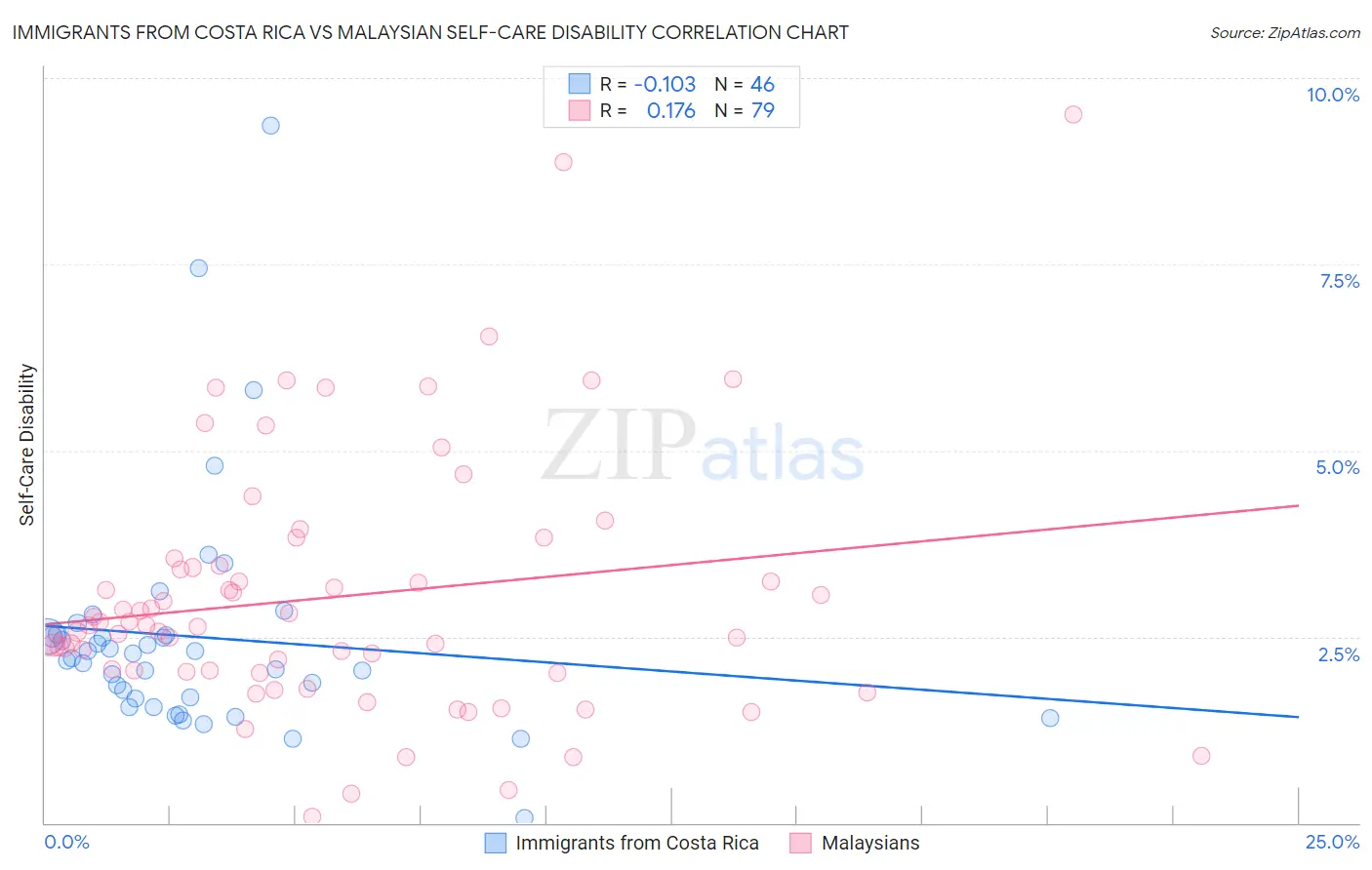Immigrants from Costa Rica vs Malaysian Self-Care Disability
COMPARE
Immigrants from Costa Rica
Malaysian
Self-Care Disability
Self-Care Disability Comparison
Immigrants from Costa Rica
Malaysians
2.4%
SELF-CARE DISABILITY
75.1/ 100
METRIC RATING
150th/ 347
METRIC RANK
2.5%
SELF-CARE DISABILITY
7.7/ 100
METRIC RATING
209th/ 347
METRIC RANK
Immigrants from Costa Rica vs Malaysian Self-Care Disability Correlation Chart
The statistical analysis conducted on geographies consisting of 204,207,185 people shows a poor negative correlation between the proportion of Immigrants from Costa Rica and percentage of population with self-care disability in the United States with a correlation coefficient (R) of -0.103 and weighted average of 2.4%. Similarly, the statistical analysis conducted on geographies consisting of 225,907,967 people shows a poor positive correlation between the proportion of Malaysians and percentage of population with self-care disability in the United States with a correlation coefficient (R) of 0.176 and weighted average of 2.5%, a difference of 4.3%.

Self-Care Disability Correlation Summary
| Measurement | Immigrants from Costa Rica | Malaysian |
| Minimum | 0.069% | 0.090% |
| Maximum | 9.4% | 9.5% |
| Range | 9.3% | 9.4% |
| Mean | 2.5% | 3.0% |
| Median | 2.2% | 2.7% |
| Interquartile 25% (IQ1) | 1.7% | 2.0% |
| Interquartile 75% (IQ3) | 2.5% | 3.5% |
| Interquartile Range (IQR) | 0.85% | 1.4% |
| Standard Deviation (Sample) | 1.6% | 1.7% |
| Standard Deviation (Population) | 1.6% | 1.7% |
Similar Demographics by Self-Care Disability
Demographics Similar to Immigrants from Costa Rica by Self-Care Disability
In terms of self-care disability, the demographic groups most similar to Immigrants from Costa Rica are Arab (2.4%, a difference of 0.040%), Romanian (2.4%, a difference of 0.050%), Basque (2.4%, a difference of 0.070%), Tlingit-Haida (2.4%, a difference of 0.10%), and Immigrants from England (2.4%, a difference of 0.10%).
| Demographics | Rating | Rank | Self-Care Disability |
| Afghans | 82.3 /100 | #143 | Excellent 2.4% |
| Costa Ricans | 80.8 /100 | #144 | Excellent 2.4% |
| Germans | 80.1 /100 | #145 | Excellent 2.4% |
| Israelis | 80.0 /100 | #146 | Good 2.4% |
| Dutch | 77.5 /100 | #147 | Good 2.4% |
| Romanians | 75.8 /100 | #148 | Good 2.4% |
| Arabs | 75.7 /100 | #149 | Good 2.4% |
| Immigrants | Costa Rica | 75.1 /100 | #150 | Good 2.4% |
| Basques | 74.0 /100 | #151 | Good 2.4% |
| Tlingit-Haida | 73.5 /100 | #152 | Good 2.4% |
| Immigrants | England | 73.5 /100 | #153 | Good 2.4% |
| Italians | 72.2 /100 | #154 | Good 2.4% |
| Pakistanis | 71.4 /100 | #155 | Good 2.4% |
| Nigerians | 70.6 /100 | #156 | Good 2.4% |
| Immigrants | Europe | 69.6 /100 | #157 | Good 2.4% |
Demographics Similar to Malaysians by Self-Care Disability
In terms of self-care disability, the demographic groups most similar to Malaysians are Central American (2.5%, a difference of 0.15%), Panamanian (2.5%, a difference of 0.23%), French (2.5%, a difference of 0.31%), Alaskan Athabascan (2.5%, a difference of 0.37%), and Immigrants from Russia (2.5%, a difference of 0.46%).
| Demographics | Rating | Rank | Self-Care Disability |
| Slovaks | 12.6 /100 | #202 | Poor 2.5% |
| Immigrants | Lebanon | 12.4 /100 | #203 | Poor 2.5% |
| Immigrants | Bahamas | 11.9 /100 | #204 | Poor 2.5% |
| Immigrants | Russia | 11.0 /100 | #205 | Poor 2.5% |
| Alaskan Athabascans | 10.4 /100 | #206 | Poor 2.5% |
| French | 9.9 /100 | #207 | Tragic 2.5% |
| Central Americans | 8.7 /100 | #208 | Tragic 2.5% |
| Malaysians | 7.7 /100 | #209 | Tragic 2.5% |
| Panamanians | 6.4 /100 | #210 | Tragic 2.5% |
| Native Hawaiians | 5.1 /100 | #211 | Tragic 2.6% |
| Samoans | 5.1 /100 | #212 | Tragic 2.6% |
| Ecuadorians | 4.7 /100 | #213 | Tragic 2.6% |
| Immigrants | Honduras | 4.7 /100 | #214 | Tragic 2.6% |
| Immigrants | Thailand | 4.5 /100 | #215 | Tragic 2.6% |
| Whites/Caucasians | 4.4 /100 | #216 | Tragic 2.6% |